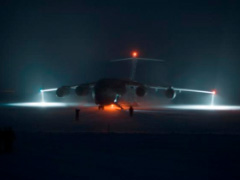
A U.S. Air Force C-17 Globemaster III sits on the runway at Pegasus airfield after making a successful landing during a night-vision mission for Winfly in 2008. Another night-vision mission is planned this year, along with four daylight flights carrying passengers to McMurdo Station.
|
Winfly 2009
The first U.S. flights since February will begin landing at McMurdo Station on Aug. 20 to prepare the research station for the start of the main summer field season, which opens in late September.
Read the Story
|
 Vantage Point
Vantage Point
The South Pole has become the place to be for scientists searching for high-energy neutrinos or to understand the nature of the dark energy that is pushing the universe apart - some of the grandest mysteries about the universe. But the Pole may offer an ideal vantage point for a different study of the cosmos.
 Drawing the Line
Drawing the Line
A science team planning to hunker down in Bull Pass in Antarctica's central McMurdo Dry Valleys would today receive a fairly simplistic map to help it protect the fragile ecosystem. Recent work will ensure that 21st century mapping technology catches up with environmental management and protection of Antarctica.
 Mapping Antarctica
Mapping Antarctica
Maps of Antarctica date back to the days of Roman geographer and astronomer Ptolemy, most of them widely creative but inaccurate until the 19th century. Today, the average person can zoom across Antarctica with Google Earth. And the imagery is only getting better.
 Cradle to Grave
Cradle to Grave
An extinct southern elephant seal colony that once existed in huge numbers along sandy and rocky beaches in Antarctica has provided new insight into how quickly a species can respond to the emergence of a new habitat as climate changes - and just as quickly disappear.